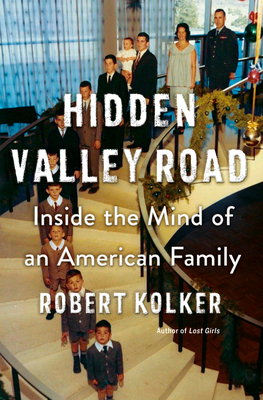
Robert Kolker’s Hidden Valley Road: Inside the Mind of an American Family is one of those rare nonfiction books that feels both monumental and intimate a sweeping account of scientific discovery intertwined with the harrowing, deeply personal story of one American family. It is at once a portrait of mental illness, a history of psychiatry, and a heartbreaking chronicle of love stretched to its limits.
At the center of this true story is the Galvin family of Colorado: Don and Mimi, and their twelve children, born between 1945 and 1965. From the outside, they embodied the postwar American dream a large, churchgoing family living in the foothills of the Rockies. But behind that façade lay a growing tragedy. One by one, six of the ten Galvin sons were diagnosed with schizophrenia. Their home on Hidden Valley Road became a place of chaos, fear, and desperate resilience.
A Family Torn Apart
Kolker tells the family’s story with sensitivity and restraint, alternating between the unfolding catastrophe within the Galvin household and the broader evolution of psychiatric research. The book exposes the emotional toll of living with mental illness long before society learned to speak openly about it. The siblings without schizophrenia suffered deeply some becoming caretakers, others victims of violence and neglect.
Mimi Galvin, the family’s matriarch, is portrayed as both tragic and controversial. Readers are left to wrestle with her choices: her insistence on keeping the family together, her denial of the extent of her sons’ conditions, and her inability to protect her daughters from the trauma happening under her roof. Kolker does not judge her outright but presents her as a woman trapped by stigma, religion, and maternal duty in an era when mental illness was met with silence and shame.
It is hard not to feel sympathy for Mimi, even as her flaws become painfully clear. Her steadfast optimism her “magical thinking” might have been the only way she could survive watching half her children lose themselves to an illness she could not understand or stop.
The Science of Schizophrenia
Beyond the family’s personal suffering lies the second thread of Kolker’s book: the story of modern psychiatry’s long and often misguided attempts to understand schizophrenia. He revisits the dark history of lobotomies, institutionalization, and theories like the “schizophrenogenic mother,” which cruelly blamed maternal coldness for the disease. Against this backdrop, Kolker introduces readers to researchers like Dr. Lynn DeLisi, whose groundbreaking work on genetics challenged decades of stigma and opened new pathways toward understanding the biological roots of mental illness.
The Galvin family’s DNA became instrumental to this research. Their tragedy, in turn, helped shape scientific progress. Decades later, the genetic data collected from their family continues to inform studies that could one day lead to more effective treatments or even prevention. It is a haunting paradox: the Galvins’ suffering contributed to hope for countless others.
Painful Truths and Lasting Impact
Reading Hidden Valley Road is not easy. Kolker spares no detail in describing the violence, delusion, and despair that defined much of the Galvins’ private lives. There are moments of abuse and betrayal that are almost unbearable to process. Yet through it all, the author maintains compassion, never exploiting the family’s pain for drama.
Some readers have noted that the book relies heavily on a few surviving family members, particularly the daughters, Lindsay and Margaret. Their perspectives dominate the latter chapters, shaping how we understand their parents and siblings. While this creates occasional imbalance, it also reinforces the emotional truth of the story the lifelong impact that trauma and silence leave on survivors.
Kolker also avoids simple conclusions. Schizophrenia remains one of medicine’s greatest mysteries, and while genetics offer new insights, the book reminds us that understanding is not the same as healing. Decades of research have improved awareness, but treatment still lags far behind need. The Galvins’ story ends not with closure but with acceptance: the idea that love endures even when reason and stability collapse.
Final Thoughts
Hidden Valley Road is as unsettling as it is illuminating. It exposes the cruelty of stigma, the limits of medicine, and the quiet heroism of those who keep loving despite the odds. Kolker’s writing is patient, clear, and humane never sensationalized, always empathetic.
This is not a book you finish lightly. It lingers, reshaping how you think about mental illness, family, and resilience. It demands that we look closely at what we prefer to hide and recognize the humanity that persists even in the darkest corners of the mind.
If you read only one nonfiction book this year, make it Hidden Valley Road. It will break your heart, but it will also deepen your understanding of what it means to care, to endure, and to hope.


